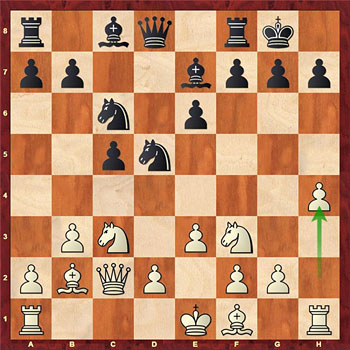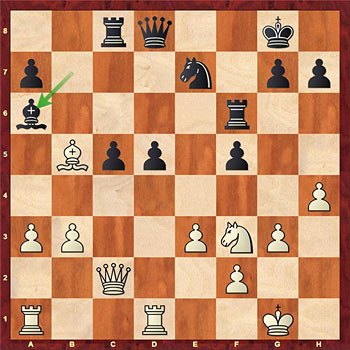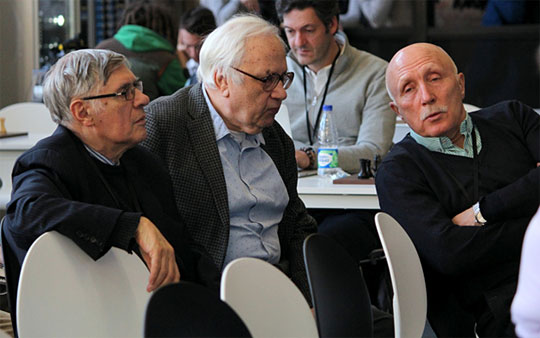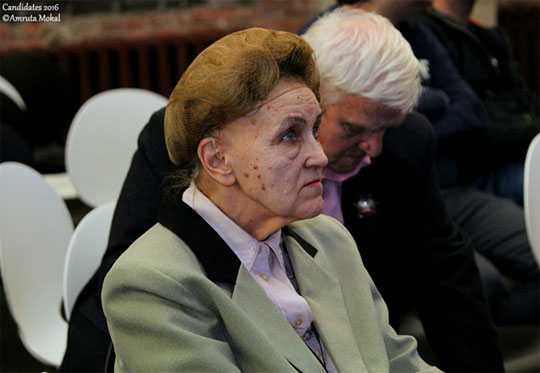



The 2016 FIDE World Chess Candidates Tournament is a 14-round event, which determines the next Challenger to Magnus Carlsen's title, is taking place in Moscow from March 10–30. Eight players, including six of the World’s top-ten rated grandmasters. The time control is 100 minutes for the first 40 moves, 50 minutes for the next 20 moves and then 15 minutes for the rest of the game, plus an additional 30 seconds per move starting from move one. The guaranteed prize fund is US $420,000.
| Round 4, Tuesday 15 March 2016 | ||
| Svidler Peter |
½-½
|
Aronian Levon |
| Caruana Fabiano |
½-½
|
Topalov Veselin |
| Karjakin Sergey |
1-0
|
Anand Viswanathan |
| Nakamura Hikaru |
½-½
|
Giri Anish |
Earlier in the day I decided to stand outside the tournament hall, at around 2.45 p.m. (the round starts at three). I wanted to capture the entry of different players coming to the tournament hall, and the people who accompany them. As it turns out all the players come walking from their hotel Four Seasons, as it is just a short distance away from the playing venue. Everyone comes with a partner, coach or a second, except for Levon Aronian and Hikaru Nakamura. Here’s the video:
If you enjoy our videos then do subscribe to the ChessBase India Youtube Channel.


1.Nf3 d5 2.e3!? What’s going on?
They have played 26 games against each other (including blitz, rapid and classical), and Karjakin has not been able to win a single game against Vishy Anand. "I am very happy as today is my first classical win against Anand", said Sergey said when he was asked how he felt about the game. Karjakin has shown a thorough disdain for theoretical continuations at this event, especially with white. Against Svidler he chose the relatively unambitious 9.Nxd4!? and today against Anand he came up with this highly interesting idea of 8.Qc2 followed by 9.h4!? Sergey thanked his seconds who had worked really hard to prepare this new idea. As Peter Svidler rightly pointed out, "To play non-theoretical lines, you need to know a lot of theory."

White’s eighth move was Qc2 which has been played only seven times before. One of the players who has tried it is the Russian Igor Lysyj. It could be possible that the 2014 Russian Champion is working as a second for Sergey. But the move 9.h4 was a complete novelty. The curious thing about the game is the Karjakin castles after a few moves, which makes h4 looks silly. As the Russian himself mentioned after the game, the move h4 provoked Vishy to play f5. This weakened a few of the squares in Black’s camp.
After the opening Vishy had a relatively fine position. But after a small inaccuracy (18…Ba6) followed by a bigger mistake (21…Qd6) the Indian player already had a highly unpleasant position. The result ending was so passive for Black that Karjakin could take his own merry time to deliver the final blow. An impressive victory for Sergey.

The side with hanging pawns must keep more pieces on the board. The fewer the pieces, the weaker these pawns become. Hence Anand’s 18…Ba6 was a positional error.

[Event "Candidates 2016"] [Site "?"] [Date "2016.03.15"] [Round "4"] [White "Karjakin, Sergey"] [Black "Anand, Viswanathan"] [Result "1-0"] [ECO "A13"] [WhiteElo "2760"] [BlackElo "2762"] [Annotator "Sagar Shah"] [PlyCount "85"] [SourceDate "2016.03.15"] {Prior to this game Anand and Karjakin have played against each other 26 times in different formats of the game - Blitz, Classical, Rapid. There have been eight decisive results all in the favour of Vishy Anand. Naturally the Indian ace has a psychological edge when facing the young Russian.} 1. Nf3 {Karjakin sticks to his policy of beginning the game with 1.Nf3 as he did against Svidler and Nakamura.} d5 2. e3 $5 {Although not completely silly, this is a highly unambitious move. In a way it takes away quite a bit of flexibility in from White's setup and makes d4 lines pretty harmless. Karjakin's natural inclination was towards avoiding Vishy Anand's home preparation.} Nf6 3. c4 e6 4. b3 Be7 5. Bb2 O-O 6. Nc3 c5 7. cxd5 Nxd5 {The game has transposed into a well-known position and it looks like we would follow some of the classical games like the ones played by Botvinnik, Larsen, Smyslov etc. However, Sergey gives this position his own modern touch!} 8. Qc2 $5 Nc6 9. h4 $5 $146 { [%cal Gh2h4] The highly interesting novelty. The idea of this move is to prepare Ng5 at some point and force White to weaken his kingside with a pawn move.} b6 10. a3 (10. Ng5 f5) 10... f5 {Anand tries to be safe and shuts the b1-h7 diagonal. What he should be really careful about is the fact that he is extending his position and some of the squares might become weak due to these pawn moves.} 11. Bb5 Bb7 12. Nxd5 exd5 (12... Qxd5 {was definitely a worthwhile alternative.} 13. Bc4 Qd6 14. Ng5 Bxg5 15. hxg5 Na5 {should not be such a huge problem for Black.}) 13. d4 {After playing the move h4, suddenly Karjakin switches to positional chess! Something has not really gone according to his plan, or has it?!!} Rc8 14. dxc5 bxc5 15. O-O {After the game I was curious as to why Sergey, who seemed all aggressive and wanted to blow Anand off the board, had suddenly become positional and played moves like d4 and 0-0. Well the reason is as simple as Karjakin explains after the game. "I wanted to provoke him into playing f5 and that's what he did!"} Bf6 (15... f4 16. Bd3 $1 $16) 16. Rfd1 (16. Bxf6 Qxf6 17. Qxc5 Ne5 $44) 16... Ne7 17. Bxf6 Rxf6 18. g3 { The position is around equal at this point. It is a well know fact that the side with the isolated or hanging pawns must keep more pieces on the board. Anand's next move breaks this rule and looks clearly like a positional error.} Ba6 $6 {[%cal Gb7a6] More the pieces get exchanged, more the c5 and d5 duo start becoming weak.} 19. Bxa6 Rxa6 20. Qc3 Rb6 21. Rac1 Qd6 $6 {Another inaccuracy. The queen is not at all well placed on d6. As Sergey shows Ne5 will threaten moves like Nc4 and Nd3.} 22. Ne5 $1 Rb7 23. Nd3 $1 {And this is what we were talking about. The hanging pawns become super weak. The c5 pawn advances and the rest is just pain for the Indian champion.} c4 24. bxc4 Rxc4 25. Qe5 {The queens have to be exchanged.} Qxe5 (25... Qc6 26. Rxc4 dxc4 27. Nc5 $18) 26. Nxe5 Rxc1 27. Rxc1 $16 {White has a better knight, a better rook, a better pawn structure and a clear plan of improving his king. The rest as they say is a matter of technique for a strong player like Karjakin.} g6 28. Rc5 Kg7 29. Ra5 Kf6 30. Nd3 Rc7 31. Ra6+ Kg7 32. Nf4 Rd7 33. Kf1 Ng8 34. Ne6+ Kf7 35. Nd4 Ne7 36. Nb5 Nc8 37. a4 Rb7 38. Rc6 Ne7 39. Ra6 Nc8 40. Rc6 Ne7 41. Rd6 Rb6 42. Rd7 a6 43. Nc3 {Anand resigned in this equal material position – a resignation that was not at all premature.} (43. Nc3 Re6 44. Nxd5 Ke8 45. Rxe7+ Rxe7 46. Nxe7 Kxe7 $18) 1-0
Let Sergey explain the nuances of his novelty 9.h4!?
Anand number two in India: In 1986, with a rating of 2405, Vishy Anand shot ahead of all his compatriots. This India number one post he preserved right until the 15th of March 2016, until the fateful game in which he lost against Sergey Karjakin. Pentala Harikrishna who has been hovering around the 2760 Elo mark for quite some time now, finally made the leap and became India number one based on the live Elo rankings.

Read more about it in ChessBase India and in this F.Sport report
Everyone in the chess world knows what a powerful theoretician Anish Giri is. However, every once in a while someone tries to test him and most of the times this experiment turns out to be unsuccessful. Today Hikaru Nakamura came all prepared from the white side of the Meran Variation of Semi Slav.

Anish on the other hand was treading cautiously. Not because he didn't know the line, but he was trying to recollect his analysis. He found all the resources for Black and avoided all the pitfalls that Nakamura had prepared. The result was a quick draw in under an hour.

Black to play. This is the key position of the entire game. Hikaru had come with the hope that Anish would play 24…Kg7 here. At first sight that looks like a natural move. But it doesn’t work because after 25.fxg6 fxg6 26.Rf7+ Kxh6 27.Raf1. White gets an advantage. However, Giri didn’t fall for the trick. He simply played 24…c5 and held the game to a draw.

RedBull and Nakamura – always together!

Levon Aronian is an artist on the chess board. Some of his calculations are so deep
that even the computers take a while to understand the intricacies
Such is modern chess – you come with a new idea in the sharp line and if the opponent hasn't studied it, he is burnt alive. But if he has it covered, it ends in a draw. In any case this was an important game as far as the theoretical development of this line is concerned.

[Event "Candidates 2016"] [Site "?"] [Date "2016.03.15"] [Round "4"] [White "Nakamura, Hikaru"] [Black "Giri, Anish"] [Result "1/2-1/2"] [ECO "D46"] [WhiteElo "2790"] [BlackElo "2793"] [Annotator "Sagar Shah"] [PlyCount "59"] [SourceDate "2016.03.15"] 1. d4 d5 2. c4 c6 3. Nc3 Nf6 4. e3 e6 5. Nf3 Nbd7 {We have the Meran System on the board and Anish Giri is considered to be quite an expert in it from both sides.} 6. Qc2 Bd6 7. Be2 {This is much more subtle than the more popular Bd3. It avoids the e6-e5 ideas in the future.} O-O 8. O-O dxc4 9. Bxc4 b5 10. Be2 Bb7 11. e4 e5 12. dxe5 Nxe5 13. Nd4 {Results-wise this line has scored very well for White. But you can be sure that when Giri plays it he has analyzed it really well.} Neg4 14. g3 (14. h3 Bh2+ 15. Kh1 Nxf2+ 16. Rxf2 Qxd4 $17) 14... Re8 (14... Bxg3 15. hxg3 Qxd4 16. Qd1 {leads to a favourable ending for White.} ) 15. Nf5 Bc5 16. Bf4 Qb6 17. Kg2 {This has all been seen in a Giri-Shirov game before. The Latvian genius had taken on f2 here. Giri plays the much better move ...g6} g6 {This is not a novelty because this has been played by Shirov recently against Svane.} (17... Nxf2 18. e5 Nd7 19. b4 Bxb4 20. Rxf2 Nxe5 21. Ne4 c5 22. Kf1 Bxe4 23. Qxe4 {Through highly concrete play Anish had refuted Black's strategy.}) 18. h3 {[%cal Gh2h3]} Ne5 $146 {The first new move of the game and quite a good one.} (18... gxf5 19. hxg4 Bd4 (19... fxg4 20. e5 $18) 20. gxf5 Bxc3 21. bxc3 c5 {Black had comfortably equalized in Svane-Shirov.}) 19. Nh6+ Kg7 20. Bg5 Bd4 21. Bxf6+ Kxf6 {Giri's king looks precariously placed on f6, but it is not so easy to get to it.} 22. f4 Nc4 23. Bxc4 bxc4 24. f5 {[#] This was the critical position of the entire game.} c5 $1 (24... Kg7 {looks humanly natural to run away from the f1 rook. After the game Nakamura said that he was hoping for Giri to make this move as he had prepared a very nice idea. Giri however said that he didn't feel Kg7 was the most human move, but instead c5 looks natural. Truly these guys are super natural!} 25. fxg6 $1 fxg6 26. Rf7+ $1 Kxh6 27. Raf1 Be3 28. Nd1 $36 {And after the complications end White will emerge with a better position.}) 25. fxg6+ Kxg6 26. Nxf7 Rf8 {Giri had passed all the tests with flying colours and it was now time for Hikaru to pull the breaks.} (26... Re7 $6 27. Nd5 $1) 27. Nd5 Qxb2 28. Ne7+ Kg7 29. Nf5+ Kg6 30. Ne7+ {And a draw was agreed. An important theoretical duel which will add to development of this variation.} 1/2-1/2
Hikaru speaks about his game with Anish but also about the role of his second Kris Littlejohn
Apart from the game analysis check out which movie Anish and Sopiko watched the night before

The couple is glad that the game ended soon and they can get back to their James Bond movie!

Peter Svidler (above) looks extremely well prepared at this event. In the English Opening 5.e4 Variation, a line that has been popularized by Anish Giri, Aronian played a new move with the 9...Nc5! But that was an expected novelty as the previous moves that had been played were not so great. Peter had studied this variation really deeply, all the way up to the 18th move.

At the start Aronian was up to the task. He managed to survive the opening and took the game into a relatively equal position. An inaccuracy on the 22nd move meant that the Russian was pressing once again. Though the position was pleasant it was not sufficient to carve out a victory. In the end many of the pieces and pawns were exchanged and with rook and three pawns for each side, the game was drawn.

Here’s a nice position from the game. It’s White to play. But you will never find the answer if you do not approach it prophylactically. Think about what is Black’s idea and come up with the solution.

[Event "Candidates 2016"] [Site "?"] [Date "2016.03.15"] [Round "4"] [White "Svidler, Peter"] [Black "Aronian, Levon"] [Result "1/2-1/2"] [ECO "A22"] [WhiteElo "2786"] [BlackElo "2757"] [Annotator "Sagar Shah"] [PlyCount "81"] [SourceDate "2016.03.15"] 1. c4 Nf6 2. Nc3 e5 3. g3 Bb4 4. Bg2 O-O 5. e4 Bxc3 6. bxc3 c6 7. Nf3 Nxe4 8. O-O d6 9. Nxe5 Nc5 $146 ({The most important game in this line went} 9... dxe5 10. Bxe4 Be6 $6 11. Ba3 Re8 12. Qb1 $1 Qxd2 (12... g6 13. Qxb7 $18) 13. Qxb7 Nd7 14. Bxc6 $18 {1-0 (37) Giri,A (2798)-Anand,V (2803) Bilbao 2015}) 10. Ng4 { This is the most challenging move by White.} (10. Nf3 Nd3 11. Ba3 Na6 {and the knight on d3 is not so easy to evict.}) 10... f5 (10... Nd3 11. Ba3 Na6 12. Ne3 {[%cal Ge3f5] The knight now controls f5 and it is not so easy to maintain control of the d3 square.}) (10... Bxg4 11. Qxg4 Nbd7 12. d4 Nf6 13. Qd1 Nce4 14. Qc2 $14) 11. Ne3 f4 12. d4 (12. Nc2 Nd3 13. Ba3 Na6 $15) 12... fxe3 13. dxc5 exf2+ 14. Rxf2 Rxf2 15. Kxf2 Qf8+ 16. Qf3 Qxf3+ 17. Bxf3 dxc5 18. Bf4 $14 {Without doubt this position is slightly in White's favour.} (18. Bg5 $5 { is a typical super grandmaster move where they force their opponent to make a move - h6 in this case and then take advantage of it later. For example because of h6, Kf7 can be attacked with Bh5+! Deep, isn't it! But this is normal stuff for guys like Aronian and Svidler.} h6 (18... Be6 19. Rb1 b6 20. Rd1 Na6 21. Bxc6 Rf8+ 22. Ke3 $14) 19. Bf4 {[%cal Gf3h5]}) 18... Nd7 (18... Bf5 19. g4 Be6 20. Rb1 b6 21. Rd1 Na6 22. Bxc6 Rf8 23. Kg3 {was what Aronian didn't like.}) 19. Bd6 $6 (19. a4 $5 {with the idea of a5-a6 is interesting.}) (19. Re1 {could have been the strongest of all.} Nf6 20. Rb1 {and now the human move could be b6 to free up the position. But unfortunately it nearly loses.} b6 21. Bxc6 Bf5 22. Rxb6 $1 axb6 23. Bxa8 {and the two bishops turn out to be too strong here.} Be4 {doesn't work due to} 24. Bxe4 Nxe4+ 25. Ke3 Nxc3 26. a3 {and the knight on c3 is sort of trapped.}) 19... Nb6 20. Re1 Bd7 21. Bxc5 Re8 {Now White doesn't really have an edge here.} 22. Rb1 Be6 $2 { A bad mistake by Aronian who simply loses a tempo.} (22... Bc8 {was more to the point as after} 23. Bxb6 axb6 24. Rxb6 Re5 $1 {the rook makes it to a5 square.}) 23. Bxb6 axb6 24. Rxb6 Bc8 25. Rb4 $1 {[%cal Ge8e5,Ge5a5] This is high level prophylactic thinking by Svidler against the Re5-a5 plan. Now to Re5 White can play Ra4.} Re5 26. Ra4 Kf7 27. Ra8 Bf5 28. Be2 (28. Rb8 Re7 29. a4 Bd3 30. c5 Ba6 $11) 28... Re7 29. c5 Kf6 30. a4 Re5 31. Rf8+ {This is an important finesse. Giving an intermediate check to push the king in an unfavourable location. Because on e7 the pawn on b7 will fall with the check and on e6 Bc4+ is strong. It is a different matter that this position is drawn but still such finesses are always important.} Kg6 32. Rb8 Rxc5 33. Rxb7 (33. c4 Ra5 34. Rxb7 Rxa4 35. Ke3 Kf6 $11) 33... Rxc3 34. a5 Bd3 35. Bxd3+ Rxd3 { The rook endgame is just drawn.} 36. a6 c5 37. a7 Ra3 38. Ke2 c4 39. Kd2 h5 40. Kc2 c3 41. h4 1/2-1/2
Peter not only speaks about the Candidates but also whether he is following the 20-20 cricket world cup

It was a refreshing change in the opening as Caruana, instead of going for the Ruy Lopez, played the Giuoco Piano as White. Both the players handled the opening phase of the game quite well and the position was relatively balanced. In the middlegame Caruana shut the centre with the move d4-d5 and the game became quite sharp. Fabiano concentrated on queenside play while Veselin tried to create inroads in the kingside with f5 break. In mutual time trouble Topalov went completely wrong and simply blundered.

In the above position Caruana, who was White, could have just taken on f6 with 41.Rxf6 and after Qxf6 play Rb2. He is simply a piece up. The neat point is that Bf5 doesn’t work due to Qxf5! Instead Fabiano went 41.R1b5 and messed up the win. It was such a superior position for the American that a full point for him was a foregone conclusion. The blunder surprisingly was the 41st move! The win was no longer apparent, and in the rook endgame the game was simply drawn. A heartbreaking result for Fabiano and quite a favourable break for Topalov.

[Event "Candidates 2016"] [Site "Moscow, Russia"] [Date "2016.03.15"] [Round "4.2"] [White "Caruana, Fabiano"] [Black "Topalov, Veselin"] [Result "1/2-1/2"] [ECO "C54"] [WhiteElo "2794"] [BlackElo "2780"] [Annotator "Sagar Shah"] [PlyCount "104"] [EventDate "2016.??.??"] [SourceDate "2016.03.15"] 1. e4 e5 2. Nf3 Nc6 3. Bc4 Bc5 4. O-O Nf6 5. d3 d6 6. c3 h6 7. a4 a5 {The players are following the game Carlsen-Adams from Wijk Aan Zee 2016. Here Carlsen went Na3 but Caruana first inserts Re1.} 8. Re1 O-O 9. Na3 Re8 10. Nc2 Ba7 11. Be3 Be6 12. Bb5 Bd7 13. Bxa7 Nxa7 14. Bc4 Nc8 {Caruana thought that this manoeuvre was a little odd, but according to Topalov Black should be completely fine here.} 15. Ne3 Nb6 16. Bb3 c6 17. h3 Be6 18. Bc2 Qc7 19. d4 { White has a slight more pleasant position.} Nc4 20. Nxc4 Bxc4 21. Qd2 Rad8 22. Rad1 Be6 23. Qe3 b6 24. Nd2 c5 25. Bd3 Re7 $6 {This doesn't seem to be a very useful move. Emil Sutovsky was very critical about it in his facebook post: "Topalov didn't have much of a problem out of the opening, but he simply stunned me by making a move Re8-e7 in a very complex position literally within a few seconds. The position required quite some thought, and it could have been a critical point"} 26. d5 Bd7 27. Ra1 {The idea of Ra1 followed by b4 is very interesting.} Nh5 28. b4 Nf4 {The knight is well placed on f4 but later on it becomes the sole reason why Black's position goes downhill. It comes in the way of other pieces.} 29. bxa5 bxa5 30. Reb1 Rf8 31. Bb5 Bc8 32. Bf1 f5 { It is an interesting position with White playing on the queenside and Black on the other wing. But soon Topalov goes wrong.} 33. c4 Ref7 34. Ra3 fxe4 35. Nxe4 Bf5 36. Rab3 {As previously pointed out the knight on f4 really stops Black from getting his required counterplay.} Bg6 37. Rb6 Qe7 $2 (37... Bxe4 { was necessary and although White is clearly better, Black doesn't lose material. Instead Topalov hallucinated and committed a blunder.}) 38. Nxd6 { White has simply won material and stands just better.} Nxh3+ 39. Qxh3 {True the rook on b1 is hanging but so is the guy on f7. So it just a complete piece up position.} Rf6 40. Nc8 $1 Qd8 {[#]} 41. R1b5 $2 {An error on the 41st move. Very surprising.} (41. Rxf6 Qxf6 42. Rb2 {is just curtains. White is a piece up and there is nothing more to play for as} Bf5 {fails to} 43. Qxf5 $18 { [%csl Rf5,Rg8][%cal Rc8e7]}) 41... Rxf2 {Now it gets a little complicated.} 42. Rxg6 Rxf1+ 43. Kh2 Qxc8 44. Qxc8 (44. Qxh6 {would have still given White excellent winning chances.}) 44... Rxc8 45. Rc6 (45. Rb7 Rf7 46. Rc6 $5 { was an option. But it is not enough to win because after} Rxb7 47. Rxc8+ Kf7 48. Rxc5 Rb4 $11 {it is just equal.}) 45... Re8 {The two black rooks combined with the e-pawn give Black enough counterplay to hold a draw.} 46. Rcxc5 e4 47. d6 Rd8 48. Rc6 Rd1 49. c5 e3 50. Rb2 Rd2 51. Rb1 e2 52. Re1 Rf8 {Quite a heartbreak for Caruana who could have been on 2.5/4 with this win.} 1/2-1/2

Look who made it to the tournament hall – Mark Izrailovich Dvoretsky! All these talented young GMs Maxim Matlakov, Ildar Khairullin and Ian Nepomniachtchi must have at some point or the other in their careers learnt from this great trainer or at least his books.

It was truly a sight to behold as the 68 year old trainer was still pretty sharp and seeing some nice variations. For example the intermediate check of 31.Rf8+ in Svidler - Aronian was pointed out by him.

Alexander Bakh, Anatoly Bykhovsky and Vladimir Tukmakov

Microscopic attention: looking at a scoresheet with a magnifying glass

Many veterans came to have a look at the games in the fourth round

There is no age limit to fall in love with the game!

Alireza Bahari Rad and Amirreza Pourramezanali from Iran enjoy the majestic chess set at the venue

Top three Indian female players Mary Ann Gomes (left), Eesha Karavade and
Soumya Swaminathan are immersed in the analysis of Anand’s game
All pictures by Amruta Mokal of ChessBase India

|
|
|||||||||||||||||||||||||||||||||||||||||||||||||||||||||||||||||||||||||||||||||||||||||||||||||||||||||||||||||||||||||||||||||||||||||||||||||||||||||||||||||||||||||||||||||||||||||||||||||||||||||||||||||||||||||||||||